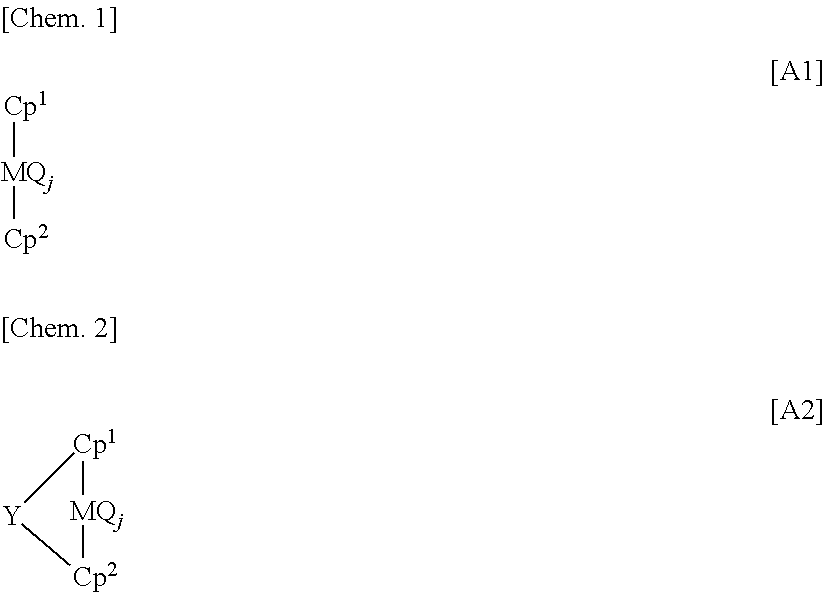Process for producing olefin polymer
a technology of olefin polymer and polymerization process, which is applied in the field of process for producing olefin polymer, can solve the problems of unindustrially advantageous techniques, and achieve the effect of favorable olefin polymerization activity and large environmental burden
- Summary
- Abstract
- Description
- Claims
- Application Information
AI Technical Summary
Benefits of technology
Problems solved by technology
Method used
Image
Examples
example 1
[0434]Using a polymerization vessel having a volume of 300 liters and equipped with a stirring blade, polymerization for a bipolymer of ethylene and butene was continuously carried out at a temperature of 90° C. Specifically, hexane (feed rate: 10.7 kg / h) was used as a polymerization solvent, and to the polymerization vessel were continuously fed ethylene at a feed rate of 4.8 kg / h, butene at a feed rate of 5.4 kg / h and hydrogen at a feed rate of 10 normal liters / h. With maintaining the polymerization pressure at 1.5 MPa-G, the catalyst preparation liquid (a1) prepared above was continuously fed to the polymerization vessel so that the feed rate might become 0.05 liter / h. Further, as an organoaluminum compound, triisobutylaluminum was separately fed to the polymerization vessel so that the feed rate might become 8 mmol / h.
[0435]Thus, a polymer solution containing 21.8% by weight of an ethylene / butene copolymer (A1) was obtained. The catalytic activity was 9400 kg / mmol-M·h. The result...
example 2
[0437]Using a polymerization vessel having a volume of 300 liters and equipped with a stirring blade, polymerization for a bipolymer of ethylene and butene was continuously carried out at a temperature of 90° C. Specifically, hexane (feed rate: 8.3 kg / h) was used as a polymerization solvent, and to the polymerization vessel were continuously fed ethylene at a feed rate of 4.8 kg / h, butene at a feed rate of 7.9 kg / h and hydrogen at a feed rate of 43 normal liters / h. With maintaining the polymerization pressure at 2.5 MPa-G, the catalyst preparation liquid (a1) prepared above was continuously fed to the polymerization vessel so that the feed rate might become 0.03 liter / h. Further, as an organoaluminum compound, triisobutylaluminum was separately fed to the polymerization vessel so that the feed rate might become 8 mmol / h.
[0438]Thus, a polymer solution containing 19% by weight of an ethylene / butene copolymer (A2) was obtained. The catalytic activity was 15000 kg / mmol-M·h. The resultin...
example 3
[0446]In a stainless steel autoclave having an internal volume of 2 liters and having been thoroughly purged with nitrogen, 1000 mL of heptane was introduced, and the temperature of the system was raised to 89° C. Thereafter, 100 mL of hydrogen was introduced and ethylene was fed to set the total pressure at 3 MPa-G.
[0447]Subsequently, 0.3 mmol of triisobutylaluminum and 0.108 ml (0.02 μmol in terms of zirconium atom calculated from the amount fed during the catalyst preparation) of the catalyst preparation liquid (a2) were forcedly introduced with nitrogen, and the number of rotations for stirring was set to 400 rpm, whereby polymerization was initiated.
[0448]Thereafter, ethylene was continuously fed to maintain the total pressure at 3 MPa-G, and the polymerization was carried out at 90° C. for 10 minutes. A small amount of ethanol was added to the system to terminate the polymerization, and then, unreacted ethylene was purged out.
[0449]From the resulting polymer solution, the solv...
PUM
| Property | Measurement | Unit |
|---|---|---|
| molar ratio | aaaaa | aaaaa |
| solubility | aaaaa | aaaaa |
| boiling | aaaaa | aaaaa |
Abstract
Description
Claims
Application Information
 Login to View More
Login to View More - R&D
- Intellectual Property
- Life Sciences
- Materials
- Tech Scout
- Unparalleled Data Quality
- Higher Quality Content
- 60% Fewer Hallucinations
Browse by: Latest US Patents, China's latest patents, Technical Efficacy Thesaurus, Application Domain, Technology Topic, Popular Technical Reports.
© 2025 PatSnap. All rights reserved.Legal|Privacy policy|Modern Slavery Act Transparency Statement|Sitemap|About US| Contact US: help@patsnap.com



